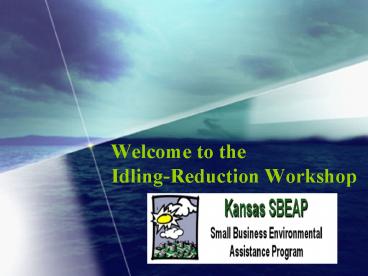Welcome to the IdlingReduction Workshop - PowerPoint PPT Presentation
1 / 21
Title:
Welcome to the IdlingReduction Workshop
Description:
States and cities may set lower standards for specific areas, and even lower ... Children's asthma symptoms increase as a result of car exhaust. ... – PowerPoint PPT presentation
Number of Views:19
Avg rating:3.0/5.0
Title: Welcome to the IdlingReduction Workshop
1
Welcome to the Idling-Reduction Workshop
2
Small Business Environmental Assistance Program
- Provides air-focused technical assistance to
Kansas small- and medium-sized businesses - Environmental regulatory compliance
- Emissions reduction and pollution prevention
- Permitting and reporting requirements
- Similar program in every state
3
Small Business Environmental Assistance Program
- SBEAP services are provided via
- Environmental hotline (800-578-8898)
- On-site visits
- Targeted regulatory or industry-specific
workshops - Publications (hard copy or electronic)
- Newsletters AIRlines, EnviroLines
- Fact sheets, manuals
- E-tips
- Web-based resources and training
- www.sbeap.org
4
Questions or Comments?
- Environmental Hotline
- 800-578-8898
- www.sbeap.org
- Or e-mail
- sbeap_at_ksu.edu
5
What is Idle Reduction?
- "Idle reduction" is typically used to describe
technologies and practices that reduce the amount
of time heavy-duty trucks idle their engines. - Reducing idle time saves fuel, engine wear, and
money. In addition, it reduces emissions and
noise.
6
Why Idle?
- Truckers idle their engines while they rest to
provide heating, cooling, electrical power, and
to keep the engine warm and the battery charged. - Service Providers idle their engines at stops to
keep interiors cool in hot weather and heated
during winter.
7
Primary Idle Reduction Technologies
- Auxiliary Power Units are small diesel-powered
engines that are installed in the truck.
Depending on the model selected, auxiliary power
units can provide heat only or heat, air
conditioning, and electric power. - Truck Stop Electrification involves modifying the
truck stop parking space to provide electric
power, heat, and air conditioning.
8
Idle Reduction Benefits
- Reduces
- Petroleum Consumption and Fuel Costs
- Engine Wear and Maintenance Costs
- Diesel Emissions
- Noise
9
Petroleum Consumptionand Fuel Costs
- Approximately 460,000 long-haul trucks currently
operating in the United States Idle reduction
technologies could reduce diesel fuel use by 838
million gallons per year. - Wasted diesel fuel translates to 1.4 billion
that could be saved by drivers using idle
reduction technologies - (Argonne National
Lab )
10
Engine WearMaintenance Costs
- Trucks idle, estimated at about 6 hours per day.
- Drivers can significantly reduce engine wear and
the associated maintenance costs. - Routine maintenance can be performed less often
and trucks can travel farther before needing an
engine overhaul.
11
Diesel Emissions
- Idle reduction technologies used by the
approximately 460,000 heavy-duty trucks operating
on diesel fuel can reduce emissions of - NOx by 140,000 tons
- CO by 2,400 tons
- CO2 by 140,000 tons
- per
year
12
Noise
- Heavy-duty trucks may produce noise ranging from
approximately 60 decibels to approximately 90
decibels. - Federal Highway Administration has set noise
levels for trucks traveling along interstate
highways at 85 decibels. - States and cities may set lower standards for
specific areas, and even lower limits at night
when trucks typically idle. - New Jersey, for example, set a level of 65
decibels for private facilities, including truck
terminals, during the day and 50 decibels at
night.
13
State Regulations
- May 2004, 18 states and local governments, had
some form of idling regulations. - Updated August 2006, 31 states and local
governments, had some form of idling regulations - The trend is growing.
14
Idle Free
15
Idling Gets You Nowhere!
- Did you know that
- Idling gives you zero miles per gallon.
- Gasoline engines consume between two and a half
and four liters of fuel per hour while idling. - Diesel engines use from one to four liters per
hour, depending on the size of the engine, the
idle speed, accessory loads and power take-offs.
16
Clean School Bus USA's
17
For Our Health...
- The average American breathes 3,400 gallons of
air a day. - Children breathe 50 more air per pound than
adults. - A single vehicle dropping off and picking up kids
at one school puts three pounds of pollution into
the air per month.
18
HEALTH EFFECTS
- Childrens asthma symptoms increase as a result
of car exhaust. - Asthma is the most common chronic illness in
children and the cause of most school absences. - Asthma is the 3rd leading cause of
hospitalization among children under 15 years.
19
Driver Health
- Exhaust emits pollutants into your vehicle as
well as the atmosphere.
20
The Smallest Pollutants Can
- Cause lung damage
- Aggravate respiratory conditions such as asthma
and bronchitis - Increase the risk of strokes and heart attacks
- Lead to cancer contribute to premature death
21
(No Transcript)































